需要添加支撑以限制结构. 如果没有支撑物,那么结构将不会是静态的并且无法解决. 重要的是要记住,任何位置的任何位置都必须在某个方向上限制结构的结构. 即. every degree of freedom must be accounted for by at least one ‘F’ in the structure.
类似于成员之间的联系, 为支撑提供了6位数字的代码,以指定受限制的节点自由度. 每个自由度必须定义为固定 ('F'), 已发行 (“ R”) 或春天(‘S’). 自由度按以下顺序:
- X翻译
- Y翻译
- Z翻译
- X旋转
- Y旋转
- Z旋转
有 3 字母类型 (或发布) 您可以使用:
- “F” – Fixed – This means the degree of freedom is fully fixed and the member will transfer this force to the node
- “R” – Released – The force is not being transferred for this degree of freedom
- “S” – Spring – The force is being transferred with some stiffness factor. 这将需要额外的输入.
引脚支持 (只允许绕 z 轴旋转) would be denoted by the code ‘FFFFFR’ whereas a roller (允许绕 z 轴旋转并沿 x 方向移动) 将被赋予代码“ RFFFFR”.

- Fixed Support – ‘FFFFFF’ – Fixed in all translations (X,和,与) 和旋转 (Mx, 我的, Mz).
- 固定 (合页) Support – ‘FFFFFR’ – Fixed in all translations (X,和,与) 而且可以绕z轴自由旋转 (在这种2D情况下).
- 托辊支撑 (在x) – ‘RFFFFR’ – Free to ‘roll’ along the x axis and rotate about the z-axis.
- 托辊支撑 (在y) – ‘FRFFFR’ – Free to ‘roll’ along the y axis and rotate about the z-axis.
- 弹簧支撑 (在y) – ‘FSFFFR’ – There is a spring support allowing some force to be transferred in the y translation.
Any support outside of these pre-configured ones can be manually typed into the “Restraint Code” field.
何时应用支撑, 固定性代码基于项目的全局坐标轴, 不是与其连接的成员的局部轴. 有关这些固定代码的更多信息, 请访问我们的博客文章 固定代码.
支撑可以限制两个轴方向或仅一个轴方向的运动. XYZxyz 格式的 6 字符方向代码指定支撑约束的方向 (X,和,Z = GLOBAL X 中的平移自由度,和,Z 轴和 x,和,z = 关于 GLOBAL X 的旋转自由度,和,Z轴).
对于每个平移和旋转自由度, 可以定义一个方向如下:
- B = 两个轴方向
- P = 正轴
- N = 负轴’)
例如: ‘BNBBBB’ = Restrains movement in both axis directions, 除了仅在负方向上支持的全局 Y 轴.
Settlements

Settlements can be used as a way to define a deflection load or fixed deflection at that location. 例如, you could apply a support and settlement displacement at a midspan of a member and the analysis will apply that displacement at that node location. 在下面的例子中, a positive settlement 的 5 增加了英寸以向上弯曲光束:
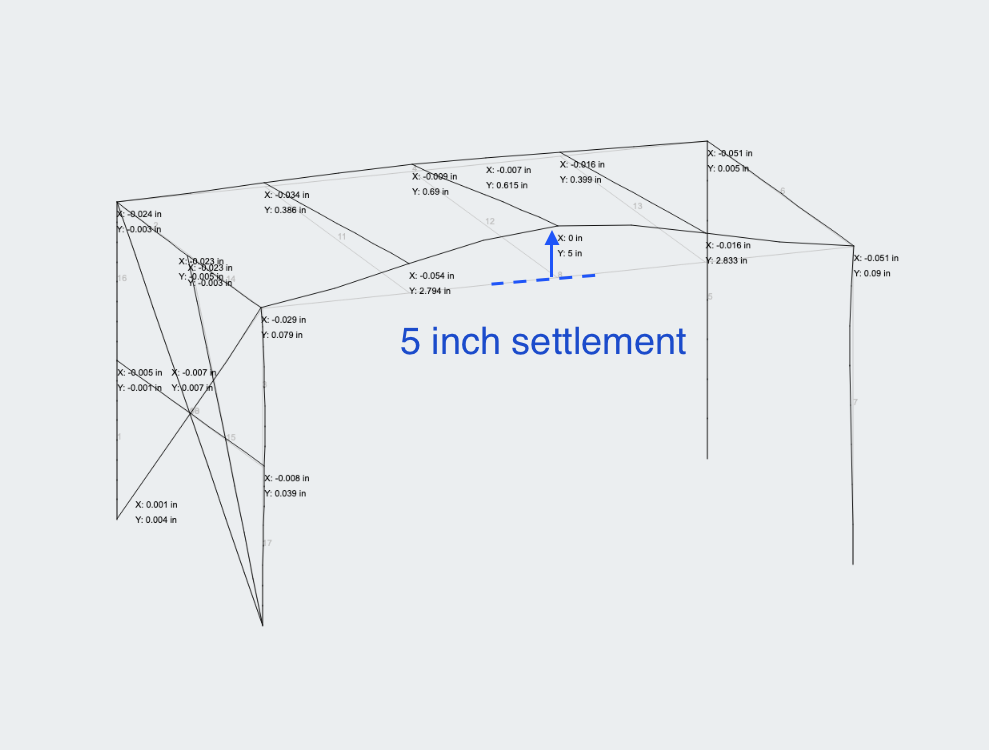
弹簧支架
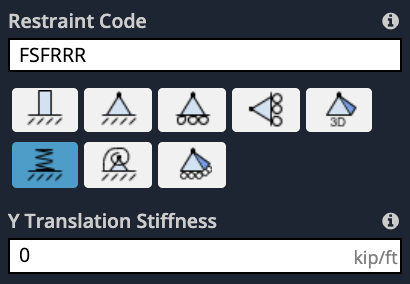
Once the user enters an ‘S” in a particular direction, 将出现另一个输入提示用户输入该特定方向的刚度. 例如. 如果用户输入垂直弹簧 (就像上面的例子) 输入 Y 刚度 会出现. 刚度输入输入为 力/距离 (基普/英尺, 千牛/米, 等等..) 它本质上表示将弹簧压缩给定距离所需的力 (脚, 仪表).
弹簧刚度 (通常表示为 ķ) C一个被计算 以几种不同的方式 (基于胡克定律 (F/排量), 或基于材料 EA/L) 或者可以由弹簧支架的制造商提供.
表面弹簧支撑
SkyCiv 具有强大的 Mat 基础弹簧集成功能. 这将帮助您将土壤弹性刚度作为弹簧支撑纳入模型中. 这种土壤属性 (路基反力模量) 从现场的岩土工程报告中获得.
为了在 SkyCiv S3D 中定义表面弹簧支撑, 第一, 您必须选择将定义支撑的级别上的所有板.
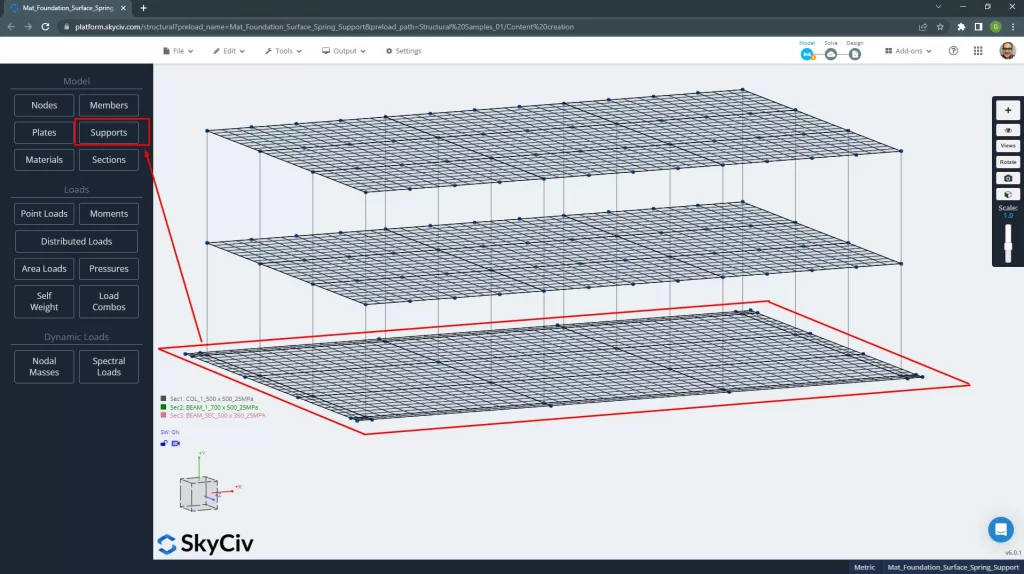
然后, go to the support button and select the option “Add a Surface Spring Support”.

当出现提示窗口时, define the “Modulus of Subgrade Reaction” (力与体积的单位), SkyCiv 将转换为节点弹簧.
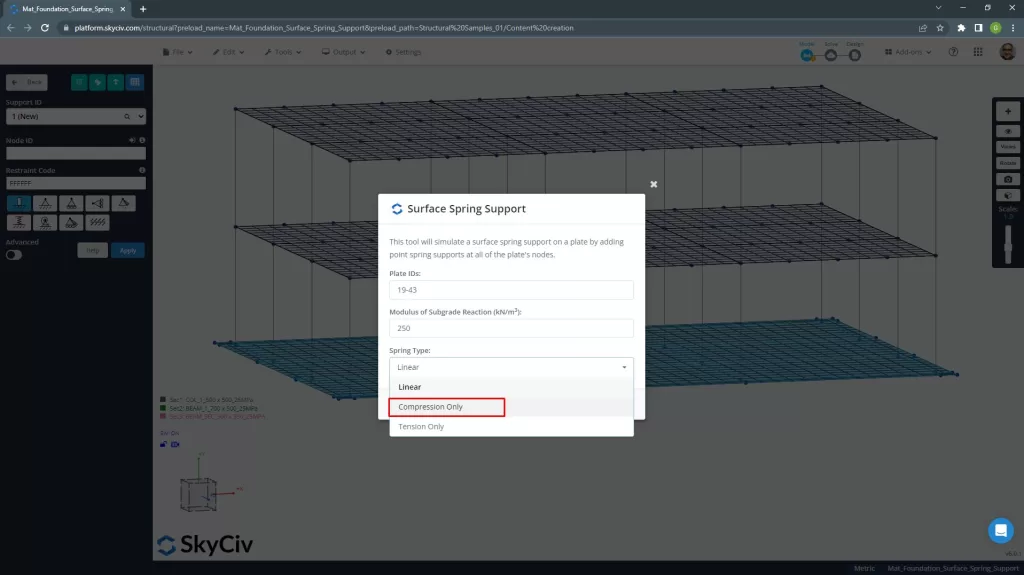
最后, 软件在网格板的每个节点上创建具有等效刚度的弹簧支撑.
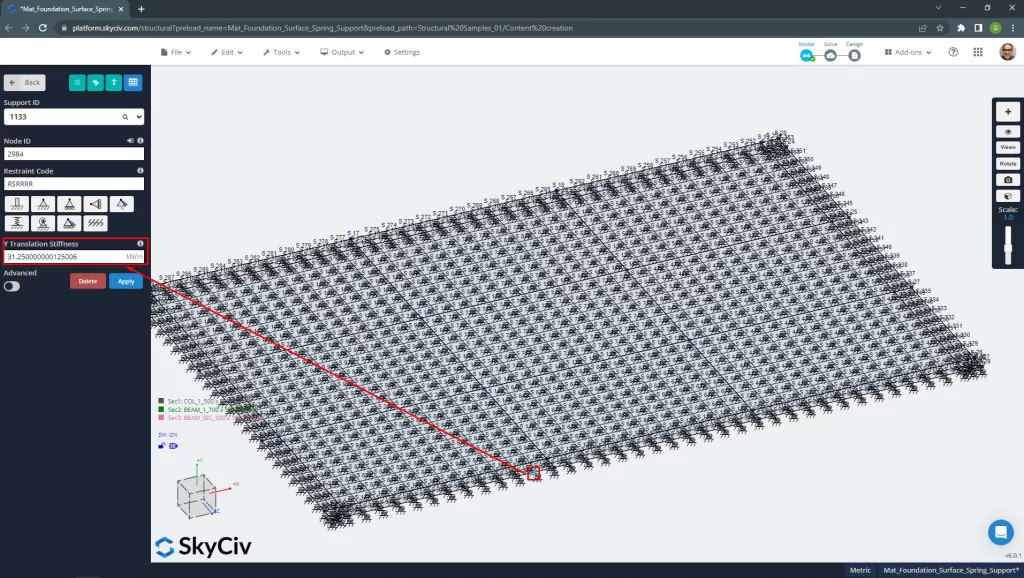
倾斜支撑
如果支撑与X-Z平面不平行, 您可以添加倾斜的支撑. 这些支撑没有完全固定或固定, but are “roller” supports that are free to move in the rotated plane. 倾斜支撑的反应结果将与支撑的旋转正交. 您必须先选择一个节点,然后单击倾斜的支撑按钮,如图所示.
建模倾斜支撑, go to the “Supports” menu, 然后单击倾斜的支撑按钮. 出现“倾斜滚子支持”弹出窗口, 输入必要的数据.

线支架
用于向板的边缘添加线支撑, 按照接下来的步骤:
- 导航到左侧面板中的支持视图
- Select “line” as the type of support (使用下拉菜单或图标)
- 键入定义板边缘的节点的 ID
- 如果每个自由度是固定的,则定义要设置的六个字符长的约束代码 (F), 释放 ([R) 或春天 (小号)
- 点击应用



